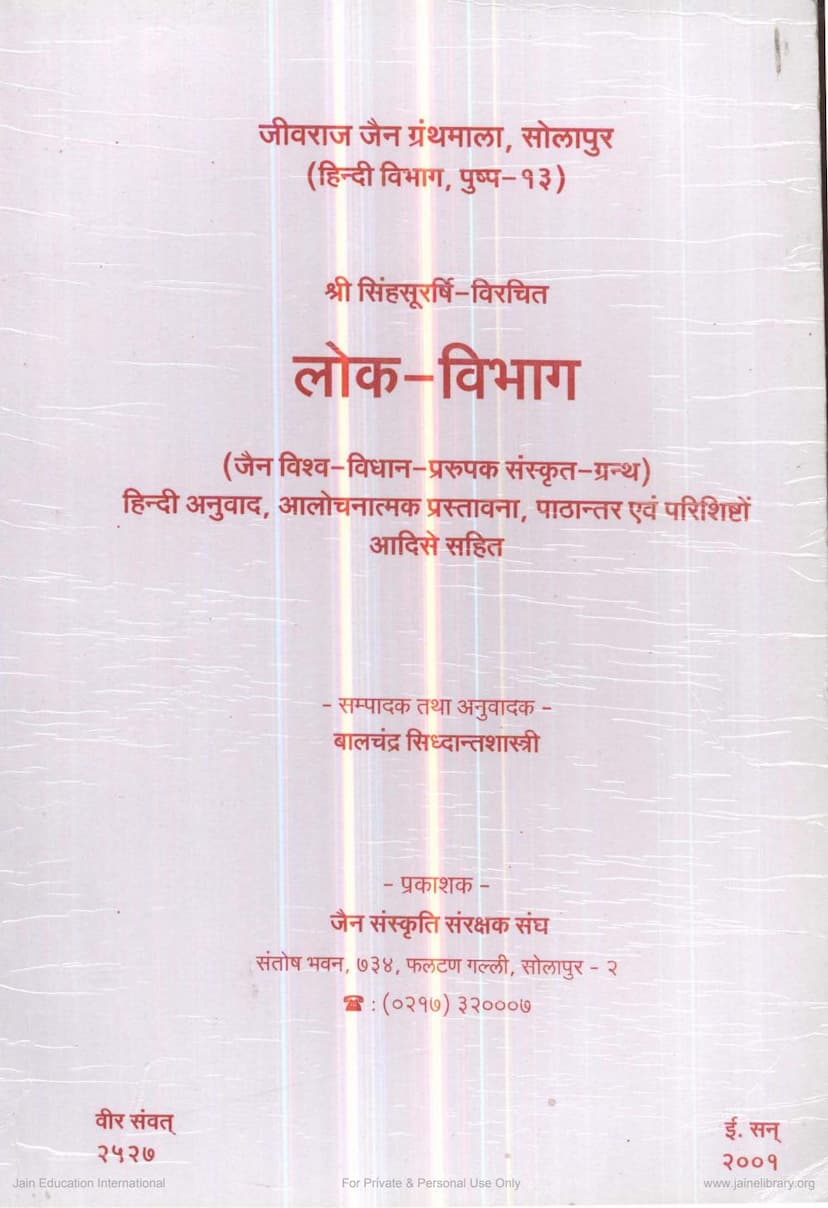Lokvibhag
Added to library: September 2, 2025

Summary
The provided text is a comprehensive publication of the Jain Sanskrit text "Lokavibhaga" (लोक-विभाग) authored by Singh Suri (श्री सिंहसूरर्षि). This edition, published in 2001 by the Jain Sanskriti Samrakshak Sangh Solapur, includes a Hindi translation, a critical introduction, alternative readings, and appendices, all compiled and translated by Pandit Balachandra Siddhantashastri (बालचंद्र सिध्दान्तशास्त्री).
The work is part of the "Jivaraj Jaina Granthamala" series (जीवराज जैन ग्रंथमाला), which focuses on Karananuyoga (करणानुयोग) texts related to Jain cosmology and philosophy. The "Lokavibhaga" is presented as the third such text in the series, following "Tiloypannatti" (तिलोयपण्णत्ति) and "Jambudiv Pannatti" (जंबूद्वीप पण्णत्ति).
Key aspects highlighted in the preface and introduction (प्रस्तावना) include:
- Authorship and Tradition: The text is attributed to Singh Suri Rishiji, who states in the concluding prashasti (praise inscription) that he is presenting the world's structure as explained by Lord Mahavir, understood by Gana-dharas (like Sudharma), and passed down through the Acharya tradition. Singh Suri claims to have simply changed the language, implying a translation or adaptation.
- Language and Time: Singh Suri likely translated the work into Sanskrit due to a decline in the study of Prakrit and the increasing prevalence of Sanskrit during his time. The preface suggests that the original Prakrit work was completed in 380 Shaka (शक संवत् 380) during the reign of King Simhavarma of Kanchi, by Muni Sarvanandi (मुनि सर्वनन्दी). The editors note that while the original Prakrit work's name is not explicitly stated in the prashasti, it was likely "Loyavibhaag" (लोयविभाग), as authors typically don't change the name when merely translating.
- Cosmological Content (Subject Matter Summary): The Lokavibhaga is a treatise on Jain cosmography, detailing the divisions of the universe. It is categorized under Karananuyoga (mathematical and cosmological branch of Jainism). The text is divided into eleven chapters, covering:
- Jambudvipa Division: Description of Jambudvipa, Mount Meru, the three divisions of the cosmos (middle, upper, lower), its geographical features like mountains, rivers, trees, cities, and Vidyadharas.
- Salt Sea Division: Details about the Lavana Samudra, its dimensions, water levels, and surrounding islands and their inhabitants.
- Human Realm Division: Description of the Dhātkikhanda and Pushkara dvipas, including their geographical features and the concept of Manushottara mountain, defining the human realm (Adhai Dwipa).
- Sea Division: Discusses the numerous islands and seas in the middle world, including Nandiśvara Island and its significance.
- Time Division: Explains the cycles of time (Avsarpini and Utsarpini), the six kālas, the first Kulakaras, and the beginning of the karma bhumi.
- Jyotiloka Division: Details about celestial bodies (sun, moon, stars), their movements, calculations, and the structure of the celestial realm.
- Bhavanavasi Lok Division: Describes the residences of the Bhavanavasis (dwellers of buildings), their Indra, families, and characteristics.
- Adholoka Division: Elucidates the seven hellish realms (prithivis), their structure, the number and types of Naraka beings, their suffering, and characteristics.
- Vyantara Lok Division: Describes the realms of the Vyantara deities, their habitats, classifications, and chieftains.
- Svarga Division: Details the heavens (Vaimanika deities), their divisions (Kalpavasis and Kalpatita), the twelve Kalpas, the realms within them (Graiveyakas, Anudish, Anuttara), the number of Vimanas, and the celestial beings residing there.
- Moksha Division: Briefly mentions the abode of the Siddhas (liberated souls) and the nature of their eternal bliss.
- Textual Features: The Lokavibhaga is primarily composed in the Anushtubh meter (अनुष्टुप् छन्द). The edition provides extensive comparisons with other major Jain cosmological texts like Tiloyapannatti, Harivamsapurana, Adipurana, and Trilokasara, highlighting unique points and potential interpolations.
- Editorial Efforts: The editor, Pandit Balachandra Siddhantashastri, expresses gratitude to all who assisted in the meticulous editing, translation, and publication process, acknowledging the challenges of working with unpublished manuscripts. He also dedicates the publication to the memory of Pt. Nathuram Premi, who played a crucial role in obtaining a vital manuscript.
The publication aims to make this important Sanskrit text on Jain cosmology accessible to a wider audience with its detailed Hindi paraphrase and scholarly apparatus. The detailed table of contents (विषयानुक्रमणिका) further outlines the extensive coverage of the Jain universe described within the text.